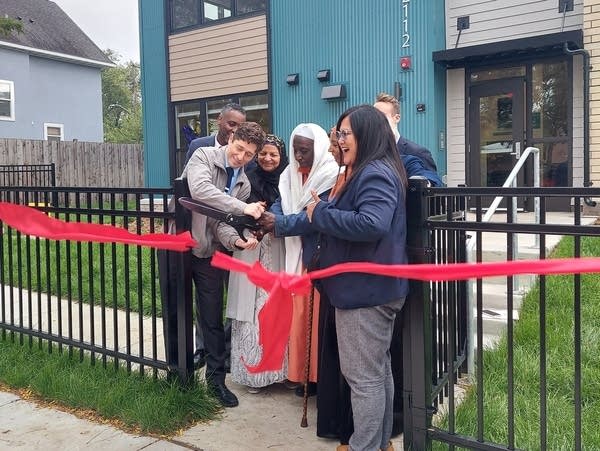Minneapolis celebrates first large-scale affordable housing project in more than 20 years

Go Deeper.
Create an account or log in to save stories.
Like this?
Thanks for liking this story! We have added it to a list of your favorite stories.
Updated: Sept. 27, 11:45 a.m.
Aniyo Rayyo and her husband Kedir Ogato entered their new affordable housing unit inside a large-scale south Minneapolis multiplex.
“I’m very, very happy,” said Rayyo’s adult daughter Bilse Kedir, who translated for her mother. “The house, the way I was waiting for it, the way I was expecting it was more than what I was thinking.”
The new multiplex is a part of Minneapolis Public Housing Authority’s Family Housing Expansion Project. Officials from the city of Minneapolis, U.S. Department of Housing and Urban Development and Hennepin County joined families Tuesday to celebrate the start of the project.
Including Rayyo and Ogato’s building, the new project will construct a total of 16 sites making a total of 84 units of deeply affordable housing, which means it’s affordable for residents making less than 30 percent of the area median income.
Turn Up Your Support
MPR News helps you turn down the noise and build shared understanding. Turn up your support for this public resource and keep trusted journalism accessible to all.
Sixteen of those units will be accessible to individuals with disabilities, and another 17 units will prioritize families receiving services through Hennepin County’s program for homeless families.
MPHA estimates the new homes will be able to serve over 420 families over the next thirty years.
The new project is the first large-scale affordable housing project undertaken by the city in over two decades, said Executive Director of MPHA Abdi Warsame at a press conference outside the new construction.
“This successful project creates a blueprint for our agency and housing authorities across the country to deliver quality cost-effective, deeply affordable family housing,” said Warsame.
Mayor Jacob Frey said Minneapolis has a long history of placing all the deeply affordable housing “in one or two areas of the city that are already quite low-income” but that now “our goal is to get deeply affordable housing in every neighborhood of the city.”
The city has allocated more than $5 million in funding for public housing annually going forward.
The applications for the new MHPA were in place before a recent ruling in which a judge struck down the city’s 2040 plan. Frey expressed his concern that a recent ruling which struck down the city’s 2040 plan could prevent affordable housing projects like this one from going forward.
“We should have affordable housing in north Minneapolis, in southwest Minneapolis, in downtown Minneapolis, in northeast — throughout” the entire city, Frey said. “In order to do that, you gotta first allow for affordable housing in these places.”

The new unit Aniyo Rayyo and her husband moved into is a part of a large modular structure —a structure made of prefabricated material in which pieces are hauled in and fitted together on site.
MPHA Director Warsame said modular construction results in less noise and fewer disruptions for neighborhoods, all while leaving a smaller carbon footprint.
U.S. Department of Housing and Urban Development Great Lakes Regional Administrator Diane Shelly says part of the funding for the new project has been made available through the Inflation Reduction Act. Money designated for green resiliency and retrofitting was used for the solar panels on the new unit.
MPHA estimates more units will be available by December. They said they maintain a list of as many as 7,500 people waiting for new homes.
Editor’s note (Sept. 27): This story has been updated to include additional comments from Mayor Jacob Frey.



